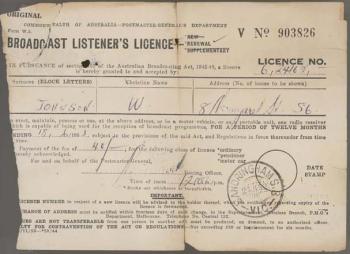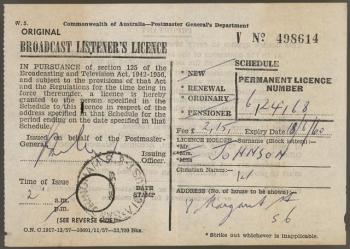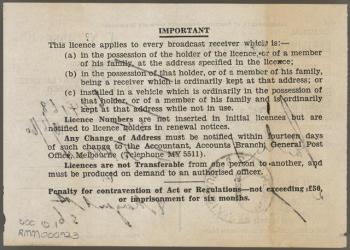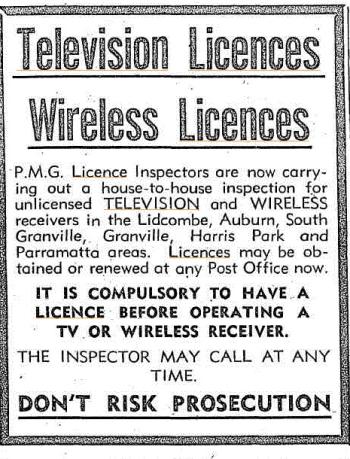NFSA curator Helen Tully writes about a time when listening to the airwaves or watching TV required a licence.

NFSA curator Helen Tully writes about a time when listening to the airwaves or watching TV required a licence.
When radio broadcasts began in Australia in 1923, they were only available to listeners that had a subscription.

A radio set, or wireless as it was more commonly known, was regulated at purchase to the wavelength of a particular radio broadcaster and listeners paid a subscription to listen to that radio station.
In November 1923 a subscription cost 3 guineas (1 guinea equalled 1 pound 1 shilling or 21 shillings) and an additional licence fee of 10 shillings was also payable to the Postal Department.1
This subscription model was obviously not sustainable as people began to build their own radio sets enabling them to receive radio programs from multiple broadcasters.
Complaints about the cost of licences also began to appear in newspapers as early as 1925. The Brighton (Vic) Justice of the Peace commented in The Age that when fining people for not paying the 63 shilling fee, 'He regretted that such a high amount had been fixed as it tended to discourage experiments in wireless, and after all, it was better for young people to be at home at night with their wireless plants than walking the streets'.
In subsequent years the listener's licence fee underwent various changes relating to cost and the classes of use. In the 1953 Broadcast Listener’s Licence (reproduced above), you can see one of the licence class options was for a motor car, however it is unclear if the 40 shillings that ‘W Johnson’ paid included this option.


With the commencement of official transmission of television in Australia in September 1956 came the need to also obtain a viewer licence.
From 1 January 1957, TV viewers were required to pay 5 pounds for their viewing pleasure and an additional 2 pounds 15 shillings for radio. Non-payment was a punishable offence with fines of up to 50 pounds.

The Postmaster-General placed ads in local newspapers warning that house-to-house inspections were imminent, as seen in this advertisement for inspections in western Sydney.
To avoid fines people took to hiding their TV antennas in chimneys and roofs and TV sets were even hidden in cupboards.3
The Postmaster-General also ran advertisements reminding people to purchase radio and TV licences.
This 1969 ad focuses on the promise of passion for those renewing their licences:
'Satisfied?', radio advertisement reminding listeners to renew their radio and TV licences, 1969. Created by The Jingle Workshop. NFSA title: 269670
These 1957 radio jingles, created by Bruce and Georgia Clarke’s Jingle Workshop, use the threat of punishment to help induce consumers to buy their licences:
'Is Your Name on File?', series of 5 radio advertisements about radio and TV licences, 1957. Created by The Jingle Workshop. NFSA title: 213062
By the 1970s, combined TV and radio licences could be purchased for $26.50. With ongoing pressure about the inequity of the costs across the community and the heavy cost of policing compliance, the federal Whitlam Government decided on 18 September 1974 to abolish radio and TV licences. However, even this did not stop the complaints.
In the following clip from CTC 7 News Canberra of 20 September 1974, journalist Jenny Hill interviews a woman about the cessation of radio and TV licences. The interviewee is outraged at the unfairness of the decision: those who have paid their annual licences were not getting reimbursed, yet those who had not paid or had been issued a summons for non-payment were receiving absolution. She concludes angrily that ‘it just doesn’t pay to be honest’:
Outrage following licence fee abolition, CTC 7 News Canberra, 20 September 1974. Courtesy: Southern Cross Austereo. NFSA title: 64393
The federal Fraser Government tried to introduce TV licence fees in 1975, recommending fees of $70.00 for a colour TV set and $50.00 for a black-and-white set, but this suggestion was met with huge opposition.
TV licences continue to exist today in the United Kingdom and selected European and Scandinavian countries. The cost of a colour TV licence in the United Kingdom in 2014 is 145 pounds and 49 pounds for a monochrome licence. The money raised provides the BBC with 75% of its funds.
1Horsham Times, 2 November 1923, p 7.
2‘High Cost of Listening in Licences’, The Age, 28 February 1925, p 17.
3Horgan, Brendan 2006, Radio with Pictures, Lothian Books, p 43.
This article was first published in 2014. The text was updated in 2023.
Want to be the first to hear stories and news from the NFSA?
Subscribe to our newsletter and never miss out.
The National Film and Sound Archive of Australia acknowledges Australia’s Aboriginal and Torres Strait Islander peoples as the Traditional Custodians of the land on which we work and live and gives respect to their Elders both past and present.